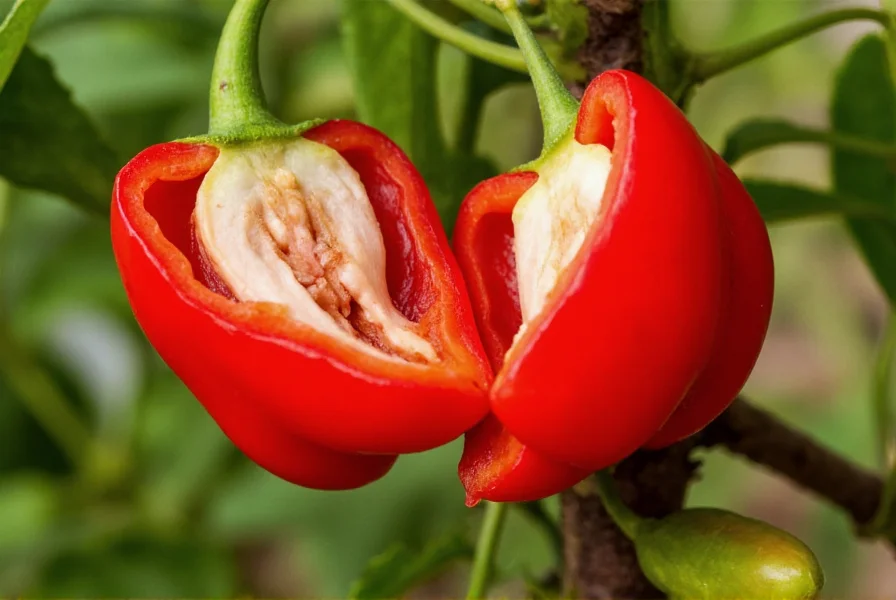Understanding the precise heat measurement of the ghost chili requires context about both the pepper itself and the Scoville scale used to measure its fiery intensity. The Scoville scale, developed by pharmacist Wilbur Scoville in 1912, measures the concentration of capsaicinoids—the compounds responsible for a chili pepper's heat—in Scoville Heat Units (SHU).
The Ghost Chili's Heat Range Explained
While many sources simplify the ghost chili's heat to "over 1 million SHU," the actual measurement varies based on growing conditions, soil composition, climate, and even the specific part of the pepper tested. Scientific testing conducted by New Mexico State University's Chile Pepper Institute confirmed the Bhut Jolokia's heat range through high-performance liquid chromatography (HPLC), the modern standard for measuring capsaicin content.
The official measurement from the 2007 study that brought the ghost chili to international attention recorded heat levels between 855,000 and 1,041,427 SHU. This testing established the ghost chili as the world's hottest pepper at that time, though it has since been surpassed by varieties like the Carolina Reaper and Pepper X.
Ghost Chili Heat Comparison Chart
| Pepper Variety | Scoville Heat Units (SHU) | Heat Level Comparison |
|---|---|---|
| Ghost Chili (Bhut Jolokia) | 855,000–1,041,427 | 200–400 times hotter than jalapeño |
| Carolina Reaper | 1,400,000–2,200,000 | Approximately 2× hotter than ghost chili |
| Habanero | 100,000–350,000 | About 1/3 the heat of ghost chili |
| Jalapeño | 2,500–8,000 | Ghost chili is 100–400× hotter |
| Bell Pepper | 0 | No heat |
Factors Affecting Ghost Chili Heat Levels
Several variables influence the precise Scoville rating of any ghost chili:
- Geographical origin: Ghost chilies grown in their native Northeast India (particularly Assam region) tend to be hotter than those cultivated elsewhere
- Soil conditions: Stressful growing conditions often increase capsaicin production
- Climate factors: Temperature fluctuations and water availability impact heat levels
- Part of the pepper: The placenta (white ribs inside) contains the highest concentration of capsaicin
- Ripeness: Fully ripe red ghost chilies typically measure hotter than green ones
History and Recognition of the Ghost Chili
The ghost chili gained international recognition when it was certified as the world's hottest pepper by Guinness World Records in 2007, with an average measurement of 1,001,304 SHU. This certification came after rigorous testing by researchers at New Mexico State University, who analyzed samples provided by an Indian military research facility that had been studying the pepper's potential applications.
Despite losing its "world's hottest" title to the Trinidad Moruga Scorpion and later the Carolina Reaper, the ghost chili remains one of the most popular super-hot peppers among chili enthusiasts and is widely used in hot sauces, culinary challenges, and even non-lethal military applications.

Practical Considerations for Handling Ghost Chilies
Working with ghost chilies requires significant caution due to their extreme heat level. The capsaicin concentration is high enough to cause:
- Skin irritation and chemical burns (always wear gloves)
- Respiratory distress when cutting or processing
- Severe eye irritation (avoid touching face after handling)
- Potential gastrointestinal distress even in small quantities
Chefs and home cooks should exercise extreme care when incorporating ghost chilies into recipes. Start with minuscule amounts—a single seed can significantly impact an entire dish. Many experienced users recommend using ghost chili in controlled applications like infused oils or hot sauces rather than adding the raw pepper directly to food.
Ghost Chili in Culinary Applications
Despite their formidable heat, ghost chilies offer a complex flavor profile with sweet, smoky, and fruity notes that emerge after the initial heat subsides. In their native Northeast India, they've been used for centuries in traditional cuisine, medicine, and even as a natural rodent deterrent.
Modern culinary applications include:
- Ghost pepper-infused hot sauces and condiments
- Specialty dishes in adventurous restaurants
- Chili eating contests and culinary challenges
- Preserves and chutneys (in very small quantities)
Common Misconceptions About Ghost Chili Heat
Several myths persist about the ghost chili's heat measurement:
- Myth: All ghost chilies measure exactly 1 million SHU
Reality: There's significant natural variation in heat levels - Myth: The Scoville test is still conducted through human tasting
Reality: Modern measurements use precise HPLC testing - Myth: Ghost chilies are dangerous to consume
Reality: While extremely hot, they're safe in culinary quantities for most people - Myth: The seeds are the hottest part
Reality: The placenta (white ribs) contains the highest capsaicin concentration
Measuring Heat: From Scoville Organoleptic Test to Modern Methods
The original Scoville Organoleptic Test involved diluting chili extract in sugar water until the heat was no longer detectable by a panel of tasters. This subjective method has largely been replaced by High-Performance Liquid Chromatography (HPLC), which precisely measures capsaicinoid concentration. The results from HPLC are then converted to Scoville Heat Units using a mathematical formula.
Understanding these measurement methods explains why ghost chili heat ratings can vary between sources—older references may cite results from the less precise organoleptic test, while modern sources use HPLC data.











 浙公网安备
33010002000092号
浙公网安备
33010002000092号 浙B2-20120091-4
浙B2-20120091-4